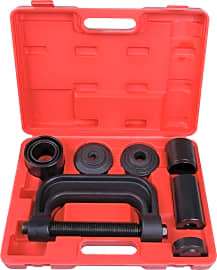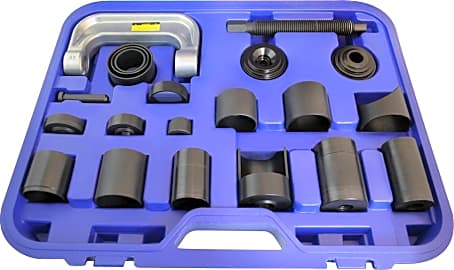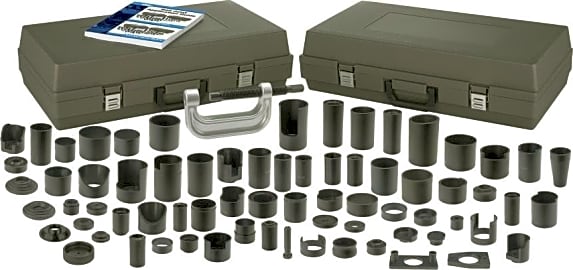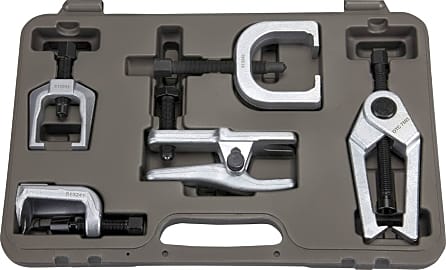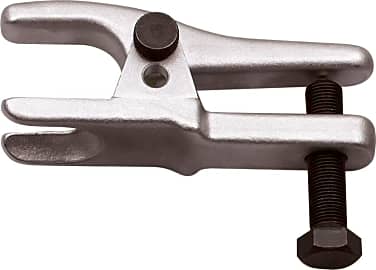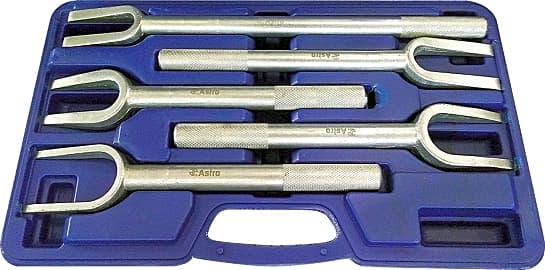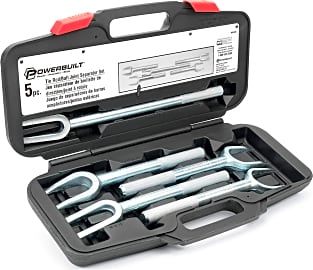The 10 Best Ball Joint Tool Sets

This wiki has been updated 36 times since it was first published in January of 2016. Whether you are an automotive professional or just prefer to repair your car or truck yourself, at some point you're going to need a ball joint tool set. With different styles for removal and installation of pressed components, they can also be used on tie rods, as well as for specialized tasks, like brake anchor pin replacement. Our selections will help you choose the best kit for your needs. When users buy our independently chosen editorial choices, we may earn commissions to help fund the Wiki.
Editor's Notes
November 12, 2020:
We've made just a few small, but noteworthy, changes to this list. First, the ATD Tools 8699 has been removed after reviewing and confirming complaints about both tool and case durability. We've added the Cartman 4-in-1, which is a high-quality and budget-friendly option from a trusted name in tools. The Astro 7865 now occupies the top spot because of its thoughtfully designed and dependably constructed parts. Similarly, the OTC 8031 has been upgraded because of its sturdily built tools and overwhelmingly positive reviews.
If you're a professional mechanic, you probably already know how to navigate the automotive tool section, but others may understandably need a little bit of guidance — or at least additional tool recommendations. While the sets featured here work well to address most front end repairs and adjustments, they're not perfectly suited to fixing all the issues a car enthusiast might encounter. For those interested in a more comprehensive collection of tools, be sure to review our list of automotive tool sets, which includes kits that can address a broader range of concerns — especially for beginners and amateur mechanics.
August 01, 2019:
Ball joint tools come in 3 general types: press-type, screw-type, and fork-type. The primary goal of all of these is to get pressed-on suspension joints to separate from each other. Press-type sets also allow you to install the components.
Press-type kits like the Astro 7897 and the OTC 6559 are preferable to other styles because they allow you to safely remove these suspension joints while leaving the components unharmed. Screw-type separators work by pressing on the joint's bolt - this risks not only damaging the boot but also compromising the internals of the joint and producing unwanted movement on the Y-axis. Still, if the component is damaged anyway and all that is needed is removal, a screw-type tool like the Gearwrench 3916D works well and is easy to use. Fork-type kits are the simplest and work by leveraging between the joint's boot and the mating surface. They also require the greatest physical exertion of the 3 types. These very often damage the boot and therefore destroy the part by allowing dirt to contaminate the lubricating grease and creating holes for the grease to leak out(which leads to joint failure). Again, if the part is already damaged and you just have to get the part off quickly, sets like the Astro 78807 work great.
Automotive repair and modification is dangerous and should only be performed by trained technicians to avoid personal injury or damage to equipment.
Special Honors
Jegs 81555 With three receiving tubes, multiple sizes of installing and receiving cups and adapters, a jackscrew, and a ball joint press, this set provides everything you need to assemble and disassemble u-joints and remove and/or install brake anchor pins. walmart.com
Capri Tools Service 5-Piece The cast steel tools in this kit are designed to remove ball joints, tie rods, and pitman arms, and can stand up to regular, high-force use. It may only come with five pieces (excluding the case), but you'll probably find that's plenty for many front end jobs. homedepot.com
Great Neck Ball and U-Joint Press Set This simple six-piece collection will help you complete basic repairs without the help of a professional mechanic. Included are two adapters, small, medium, and large rings, a pressure screw, and a highly visible lime green c-frame tool. It comes with a limited lifetime warranty. autozone.com
Choosing the Right Ball Joint Tool Set
For indeed even a great ball joint tool kit will cost you a fraction of the expense of having your vehicle's ball joints serviced by a mechanic.
The price tag of a top-of-the-line ball joint tool set may be a bit off-putting to some people at first glance, but it will seem much less daunting when you know a thing or two about the potential costs of professional ball joint repair or replacement. For indeed even a great ball joint tool kit will cost you a fraction of the expense of having your vehicle's ball joints serviced by a mechanic. And if you settle for a midrange ball joint tool kit, you stand to pay ten times less than you would for a repair conducted by a professional.
Unlike many tool kits, such as a set of socket wrenches, for example, tools designed for servicing ball joints are purpose-built and serve few if any other purposes. That's not a limitation, though, but rather a liberation: you don't buy a ball joint tool set for an other purpose than repairing or replacing this specific type of hardware, so you are free to shop based on tool quality and set price without worrying about range of function or versatility.
Any ball joint kit worth your consideration will have a large C-frame press and a thick screw that can be threaded through said frame. Some kits contain larger C-frames than others, and these larger frames may be necessary if you plan to work on certain trucks, Jeeps, or SUVs with larger ball joint components. Most kits will come with a half dozen or so adapters, while others will come with more than a dozen and a half adapters. In other words, while all ball joint kits tend to have similar parts included, some of these parts are specially designed for larger vehicles, and some kits simply include more variations of the same type of component. If you know precisely for which vehicle you are buying a set, then there's no reason to own parts that won't work with it; if you're a mechanic who works on all sorts of vehicles, then by all means opt for the larger, more expansive set.
Also don't overlook the importance of the instructions and charts that come with a given ball joint tool kit. Some sets come with easy-to-use, graphically illustrated guides, while others include tools and a case only. If you're not an experienced DIY car repairman or a trained professional, then do yourself a favor and opt for a kit with a manual.
What Exactly Is a Ball Joint, Anyway?
If you're not quite clear on what a ball joint is, you're probably getting ahead of yourself in terms of considering a tool kit purpose built to service these components. However, anyone dedicated to learning DIY vehicle repairs and maintenance will need to learn all about ball joints at some point, and if you prefer to dive into a hobby with both feet, you might as well learn fast and then acquire the tools you'll need to apply your new knowledge.
Without a ball joint, your car's shock absorbers would be essentially pointless and your car would be as rigid and rickety as a horse-drawn carriage from centuries past.
Simply put, a ball joint is a ball-shaped (usually called "spherical" by automotive pros) bearing that connects a control arm of your vehicle's steering knuckles (which are connected directly to the wheel assembly) to the automobile's suspension system. Because ball joints allow for a decent range of motion, they can help transfer the input you give by turning the wheel -- also known as steering -- to the wheels themselves even as the car bounces around over potholes, debris, speed bumps, and so forth. Because the ball joint flexes about, the car remains under control even as the suspension system moves up and down while mitigating the jostling caused by road and driving conditions.
Without a ball joint, your car's shock absorbers would be essentially pointless and your car would be as rigid and rickety as a horse-drawn carriage from centuries past. The location and responsibility of the ball joint also sees an exceptional amount of pressure put on this diminutive component, so ensuring that all the ball joints in your vehicle are in good repair and working properly is of immense importance for safe driving. Learn how to inspect and manage these joints yourself, or else have a trusted mechanic inspect your car's ball joints on at least an annual basis.
How to Tell If Your Ball Joints Are Bad
Whether or not you are planning to repair or replace the ball joints in your car, truck, or SUV yourself using your handy ball joint tools, or if you are going to take the vehicle to the mechanic to let the professionals handle the maintenance, if you suspect your car's ball joints are damaged or wearing out, don't delay in servicing these all-important components. A failed ball joint can lead to much more costly repairs involving the wheel, axle, steering knuckles, and more, and can also create an extreme safety hazard should a joint fail while you are driving at speed on a highway or in traffic.
In the best case situation, a failed ball joint will still lead to a pricey repair.
When a ball joint fails, the wheel to which it is attached can fold under the vehicle, causing the driver to lose control and resulting in a catastrophic crash in the worst case scenario. In the best case situation, a failed ball joint will still lead to a pricey repair. So catch the joints before they fail.
One of the telltale signs of a ball joint nearing the end of its operations life is uneven wear on your tires. If you notice "feathering" wear on your tires -- when when the tread ribbing is worn down more and/or worn more smoothly on one side of the tire than on the other -- the ball joint (or joints) connected to that wheel may be failing.
Also listen for clunking noises emanating from your wheels, especially as your drive over uneven roads or over obstacles like train tracks or small speed bumps. The knocking noise may be the spherical bearing of the weakened ball joint colliding with the frame into which it should fit snugly.
A surefire way to tell if a ball joint is failing is to lift the vehicle up -- ideally using a full-sized hydraulic press that can elevate the car off the ground, but a jack and jack stand combination will suffice as well -- and to apply a bit of torque pressure to the ball joint itself. If it can be moved up and down and/or back and further, depending on its orientation, the component is likely worn beyond safe the limit of operation and must be replaced.


